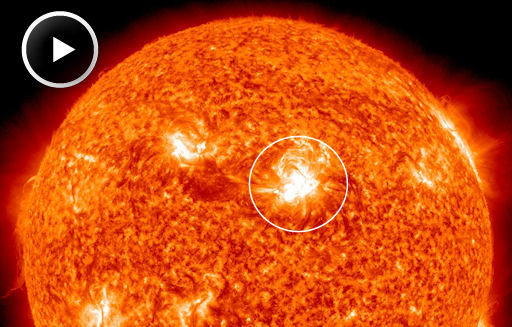Metallic photos of the sun by renowned photographer Greg Piepol bring together the best of art and science. Buy one or a whole set. They make a stellar gift. | | |
AURORAS INVADE THE USA: Earth's magnetic field is still reverberating from a CME strike on March 10th. During the past 24 hours, Northern Lights have descended as far south as Wisconsin, Minnesota, and Michigan in the United States. "At one point the lights filled more than half of the entire sky," says Travis Novitsky, who sends this self-portrait from Grand Portage, MN:

"We stood in awe at not only the movements but also the colors we were seeing-- green, red, purple, and white," says Novitsky. "I was almost in a trance staring at this amazing show and I had to remind myself to keep taking pictures!"
Solar wind conditions favor more geomagnetic storming in the hours ahead. Sky watchers--even those in the continental United States--should remain alert for auroras.
UPDATED: March 2011 Aurora Photo Gallery
[previous Marches: 2010, 2009, 2008, 2007, 2006, 2005, 2004, 2003, 2002]
X-FLARE: March 9th ended with a powerful solar flare. Earth-orbiting satellites detected an X1.5-class explosion from behemoth sunspot 1166 around 2323 UT. A movie from NASA's Solar Dynamics Observatory shows a bright flash of UV radiation plus some material being hurled away from the blast site:

Movie formats: 4 MB gif, 1.2 MB iPad, 0.3 MB iPhone
UPDATE (March 10 @ 1800 UT): Newly-arriving coronagraph data from the Solar and Heliospheric Observatory show no bright CME emerging from this eruption. Some material was surely hurled in our direction, but probably not enough for significant Earth-effects.
After four years without any X-flares, the sun has produced two of the powerful blasts in less than one month: Feb. 15th and March 9th. This continues the recent trend of increasing solar activity, and shows that Solar Cycle 24 is heating up. NOAA forecasters estimate a 5% chance of more X-flares during the next 24 hours.
SOLAR FLARE ALERTS: Would you like a call when the next X-flare erupts? Sign up for Spaceweather PHONE.
Potentially Hazardous Asteroids (
PHAs) are space rocks larger than approximately 100m that can come closer to Earth than 0.05 AU. None of the known PHAs is on a collision course with our planet, although astronomers are finding
new ones all the time.
On March 11, 2011 there were 1204 potentially hazardous asteroids.
Notes: LD means "Lunar Distance." 1 LD = 384,401 km, the distance between Earth and the Moon. 1 LD also equals 0.00256 AU. MAG is the visual magnitude of the asteroid on the date of closest approach. | | The official U.S. government space weather bureau |
| | The first place to look for information about sundogs, pillars, rainbows and related phenomena. |
| | Researchers call it a "Hubble for the sun." SDO is the most advanced solar observatory ever. |
| | 3D views of the sun from NASA's Solar and Terrestrial Relations Observatory |
| | Realtime and archival images of the Sun from SOHO. |
| | from the NOAA Space Environment Center |
| | the underlying science of space weather |
| | for out-of-this-world printing and graphics |

